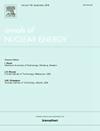Parametric investigation of mercury cell electrolysis for isotopic separation of Li using coupled numerical methods
IF 1.9
3区 工程技术
Q1 NUCLEAR SCIENCE & TECHNOLOGY
引用次数: 0
Abstract
Fusion reactors will be one of the major resources of future energy. The fuel required for these reactors is deuterium–tritium (D-T). Tritium, which is not naturally available, is produced by the collision of neutrons with 6Li in the environment of these reactors. Various compounds, including lithium hydroxide (LiOH) solution, can be used to extract 6Li. The natural abundance of 6Li is approximately 7.5%, which is insufficient for producing tritium used in fusion reactors and necessitates further enrichment. Various methods, including electrolysis, can be employed to increase 6Li enrichment. In this research, the electrolysis exchange (ELEX) method has been used to extract 6Li from LiOH with a favorable separation factor. The simulation of this process using the design of a mercury cell has been conducted through Comsol 6.1 software. This geometry (mercury cell) is a sloping space for continuous movement of mercury. Mercury, which is actually the cathode in this system, absorbs lithium isotopes, especially 6Li, due to the mobility of this isotope compared to 7Li, and increases the percentage of 6Li abundance at the output of the system (LiHg). Electrochemical physics, involving the solution of Nernst-Planck equations, and turbulent flow physics, governed by the Navier-Stokes equations, have been employed to carry out the electrolysis process. It should be noted that, given the significance of diffusion coefficient values in the process of isotope separation by electrolysis, these values have also been determined through molecular dynamics simulations. Finally, and based on the parametric study that has been conducted on all the parameters affecting the electrolysis process, a separation coefficient of about 1.05 has been obtained. This separation coefficient, which has also been compared with experimental references, has been stabilized after approximately 3 h of operation.
求助全文
约1分钟内获得全文
求助全文
来源期刊

Annals of Nuclear Energy
工程技术-核科学技术
CiteScore
4.30
自引率
21.10%
发文量
632
审稿时长
7.3 months
期刊介绍:
Annals of Nuclear Energy provides an international medium for the communication of original research, ideas and developments in all areas of the field of nuclear energy science and technology. Its scope embraces nuclear fuel reserves, fuel cycles and cost, materials, processing, system and component technology (fission only), design and optimization, direct conversion of nuclear energy sources, environmental control, reactor physics, heat transfer and fluid dynamics, structural analysis, fuel management, future developments, nuclear fuel and safety, nuclear aerosol, neutron physics, computer technology (both software and hardware), risk assessment, radioactive waste disposal and reactor thermal hydraulics. Papers submitted to Annals need to demonstrate a clear link to nuclear power generation/nuclear engineering. Papers which deal with pure nuclear physics, pure health physics, imaging, or attenuation and shielding properties of concretes and various geological materials are not within the scope of the journal. Also, papers that deal with policy or economics are not within the scope of the journal.
 求助内容:
求助内容: 应助结果提醒方式:
应助结果提醒方式:


